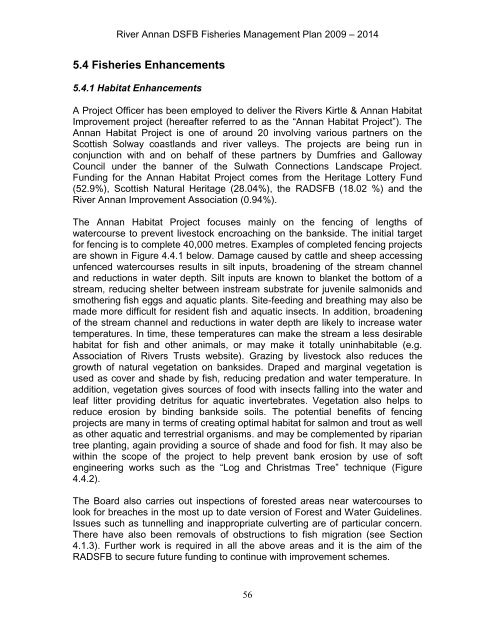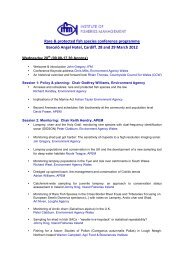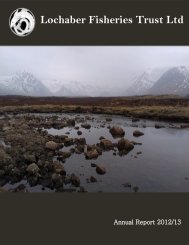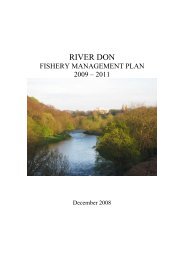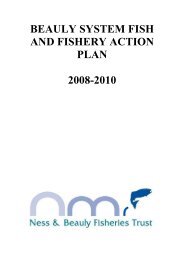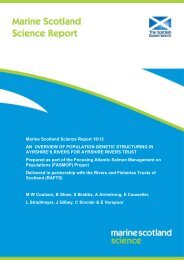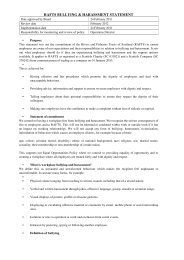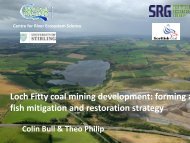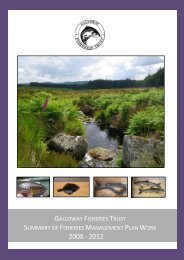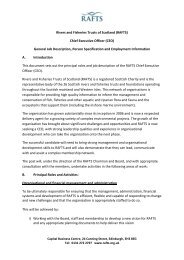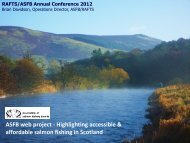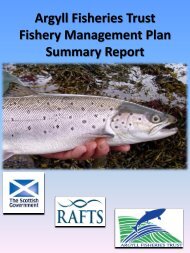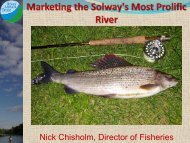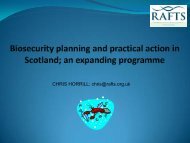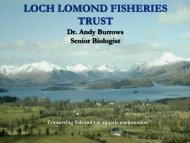You also want an ePaper? Increase the reach of your titles
YUMPU automatically turns print PDFs into web optimized ePapers that Google loves.
River <strong>Annan</strong> DSFB Fisheries <strong>Management</strong> <strong>Plan</strong> 2009 – 20145.4 Fisheries Enhancements5.4.1 Habitat EnhancementsA Project Officer has been employed to deliver the Rivers Kirtle & <strong>Annan</strong> HabitatImprovement project (hereafter referred to as the “<strong>Annan</strong> Habitat Project”). The<strong>Annan</strong> Habitat Project is one of around 20 involving various partners on theScottish Solway coastlands and river valleys. The projects are being run inconjunction with and on behalf of these partners by Dumfries and GallowayCouncil under the banner of the Sulwath Connections Landscape Project.Funding for the <strong>Annan</strong> Habitat Project comes from the Heritage Lottery Fund(52.9%), Scottish Natural Heritage (28.04%), the RADSFB (18.02 %) and theRiver <strong>Annan</strong> Improvement Association (0.94%).The <strong>Annan</strong> Habitat Project focuses mainly on the fencing of lengths ofwatercourse to prevent livestock encroaching on the bankside. The initial targetfor fencing is to complete 40,000 metres. Examples of completed fencing projectsare shown in Figure 4.4.1 below. Damage caused by cattle and sheep accessingunfenced watercourses results in silt inputs, broadening of the stream channeland reductions in water depth. Silt inputs are known to blanket the bottom of astream, reducing shelter between instream substrate for juvenile salmonids andsmothering fish eggs and aquatic plants. Site-feeding and breathing may also bemade more difficult for resident fish and aquatic insects. In addition, broadeningof the stream channel and reductions in water depth are likely to increase watertemperatures. In time, these temperatures can make the stream a less desirablehabitat for fish and other animals, or may make it totally uninhabitable (e.g.Association of Rivers Trusts website). Grazing by livestock also reduces thegrowth of natural vegetation on banksides. Draped and marginal vegetation isused as cover and shade by fish, reducing predation and water temperature. Inaddition, vegetation gives sources of food with insects falling into the water andleaf litter providing detritus for aquatic invertebrates. Vegetation also helps toreduce erosion by binding bankside soils. The potential benefits of fencingprojects are many in terms of creating optimal habitat for salmon and trout as wellas other aquatic and terrestrial organisms. and may be complemented by ripariantree planting, again providing a source of shade and food for fish. It may also bewithin the scope of the project to help prevent bank erosion by use of softengineering works such as the “Log and Christmas Tree” technique (Figure4.4.2).The Board also carries out inspections of forested areas near watercourses tolook for breaches in the most up to date version of Forest and Water Guidelines.Issues such as tunnelling and inappropriate culverting are of particular concern.There have also been removals of obstructions to fish migration (see Section4.1.3). Further work is required in all the above areas and it is the aim of theRADSFB to secure future funding to continue with improvement schemes.56


